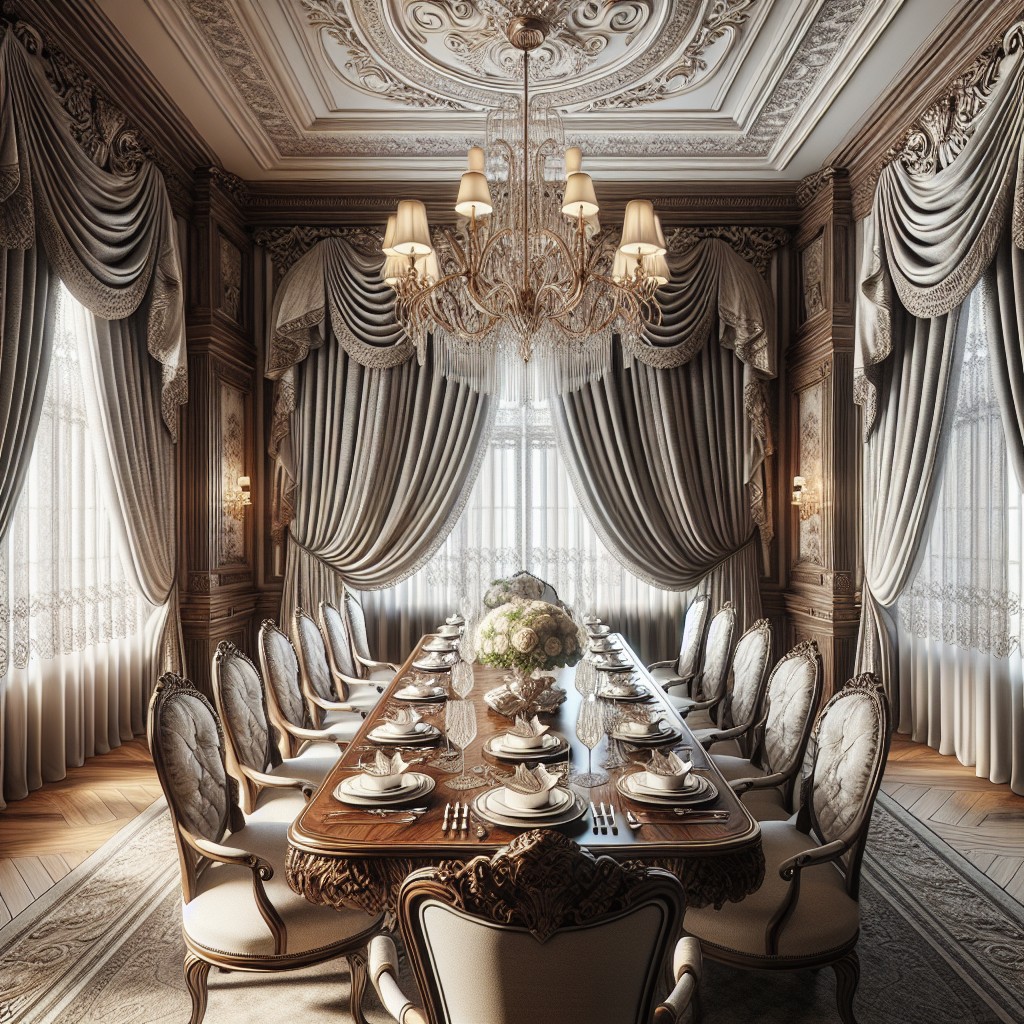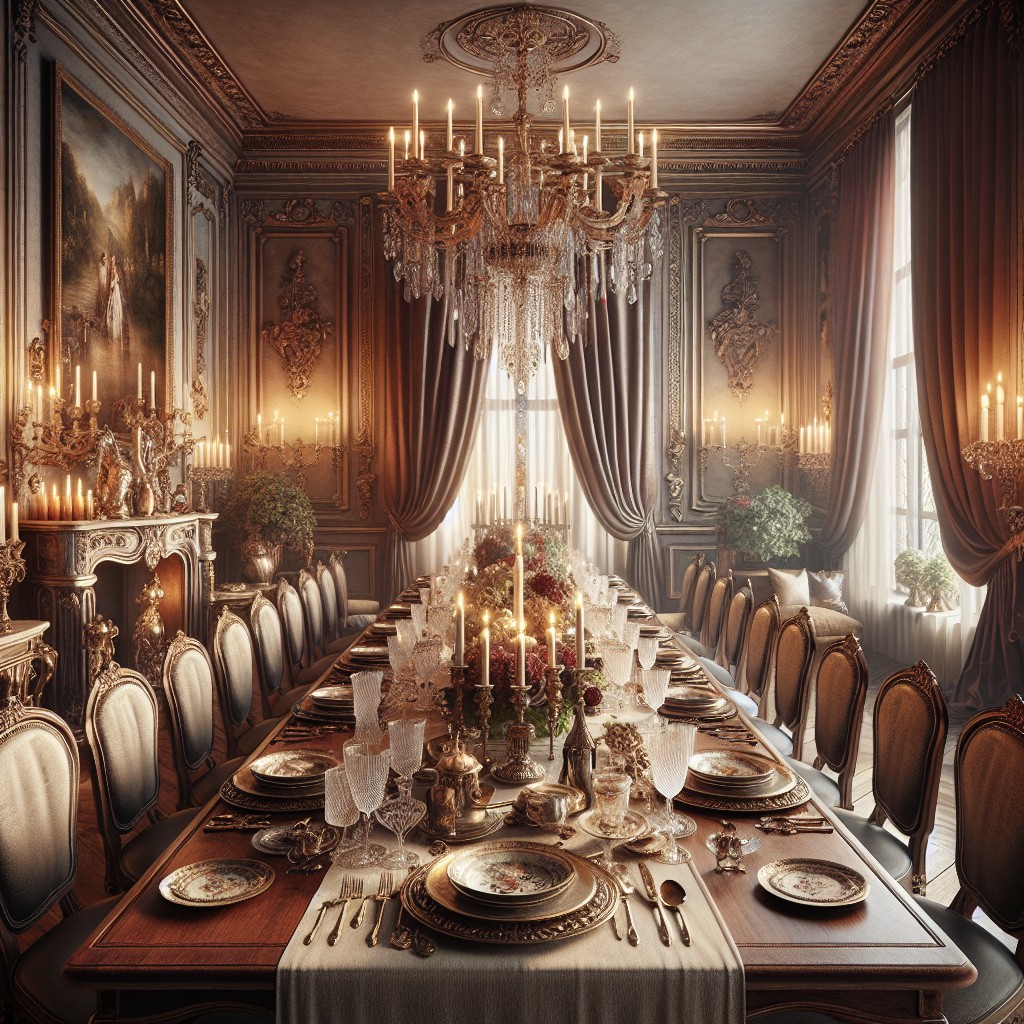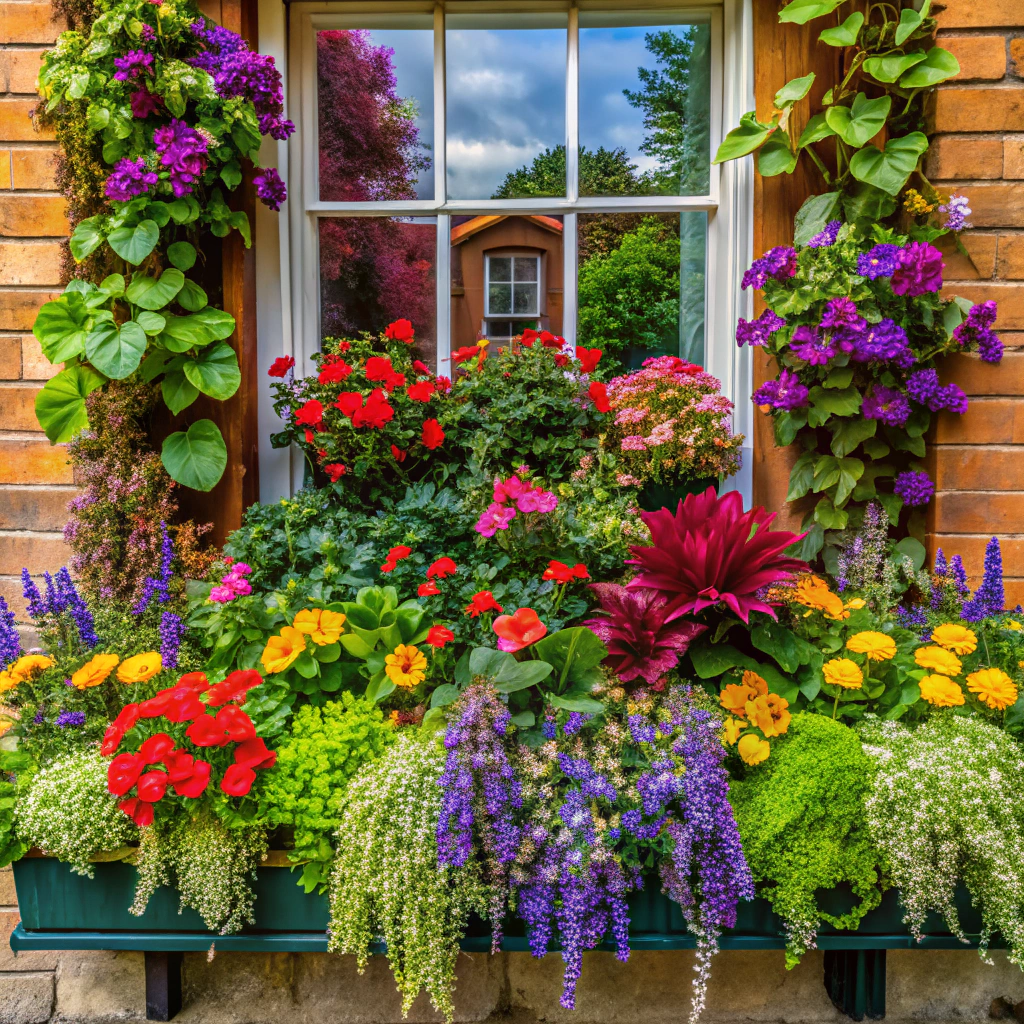Choosing the right curtains for your formal dining room can dramatically transform its aesthetics, and because this decision can be challenging given the plethora of options, this comprehensive guide will offer insights on both selection and styling.
Key takeaways:
- Fabric choice sets the tone – heavy for luxury, light for classic appeal
- Measure for perfect fit – width, fullness, length, and function
- Choose color and pattern to complement the room’s scheme and mood
- Length of curtains impacts formality – floor-length for elegance
- Select curtain styles that elevate the room’s aesthetic – pinch pleat, puddle-length, sheer, box pleat, goblet pleat
Importance of Fabric Choice

The selection of fabric can transform the ambiance of a dining room, setting the stage for formal meals and special occasions. Heavier materials like velvet or silk convey luxury and can help dampen acoustics for a more intimate atmosphere.
In contrast, lighter fabrics such as linen or cotton offer a breezy, classic appeal while still maintaining a refined look. It’s essential to consider the fabric’s durability and ease of cleaning, as the dining area is prone to spills and stains.
Opt for textiles that balance functionality with elegance, ensuring they can withstand regular use while exuding sophistication. Keep in mind that the transparency of the fabric affects privacy and light control – sheer curtains allow natural light to filter through, while more opaque options provide seclusion and shade.
Measuring for Perfect Fit

Before you begin measuring, arm yourself with a reliable metal tape measure — cloth ones can stretch, leading to inaccuracies.
For width, measure the length of the rod between the decorative finials. If you haven’t installed the rod, aim for it to be 8-12 inches wider than the window frame for optimal fullness and function.
Curtains should be 2 to 2.5 times the width of the window. This ensures they look adequately full when closed.
For a traditional look, aim for curtains to just kiss the floor or have a half-inch break. For a dramatic touch, go for a slight puddle with an extra 1-2 inches of fabric pooling on the floor.
If your dining room sees frequent use, opt for shorter curtains that hang just below the sill to make sure they stay clean and out of the way.
Remember, the right measurements are foundational in achieving a polished aesthetic where curtains enhance both the window and the room’s overall design.
Selecting the Right Color and Pattern
When choosing hues, consider the room’s existing color scheme. Aim for harmony by selecting shades that complement your walls, flooring, and furniture. Neutrals exude elegance, while deeper tones can add a touch of sophistication and drama.
Patterns require careful consideration. Large, bold prints can become a room’s centerpiece, ideal for rooms that need a visual lift. Conversely, small, subtle patterns lend a refined touch without overwhelming the space.
Remember that light colors and minimal designs can make the room feel larger and airier. Conversely, dark colors or dense patterns may create a cozier, more intimate atmosphere.
It’s also essential to think about the mood. Cool blues and greens often convey serenity, making them a good choice for an area meant for relaxed, unhurried meals. Warm colors like red or orange might stimulate conversation and appetite, aligning well with the sociable nature of dining.
Lastly, consider natural and artificial lighting. Colors and patterns may appear differently throughout the day or under various lighting conditions. Where possible, obtain fabric swatches and observe how they interact with light and the dining room’s ambiance before making your final decision.
The Impact of Curtain Length On Formality
Curtain length can set the tone for the entire room. Floor-length curtains convey a sense of elegance and formality, traditionally brushing just above the floor or creating a slight puddle of fabric for a luxurious effect.
For a dramatic statement, opt for curtains that billow onto the floor with a couple of extra inches of fabric. Conversely, curtains that fall short of the floor might be perceived as casual or unfinished in a formal dining room setting.
When opting for valances or shorter curtain styles, consider the architecture and whether it complements the room’s aesthetic and desired formal ambiance. Remember, precision in measurement is key to achieving a polished look.
Curtain Styles Suitable for Formal Dining Rooms
Elegance meets function when selecting curtain styles that elevate the aesthetic of a formal dining room. Consider classic pinch pleat drapes that present a tailored look, inviting a touch of sophistication.
Puddle-length curtains offer a dramatic flair, subtly pooling on the floor, ideal for delivering a grand statement. For a timeless feel, box pleat curtains ensure a structured, orderly appearance, excellently paired with ornate decor.
Alternatively, goblet pleat curtains create a luxurious ambiance thanks to their rounded, goblet-like headings, perfect for rooms with high ceilings. Sheer curtains layered underneath heavier drapes blend privacy with soft, diffused lighting, crafting an inviting atmosphere for evening dinners.
For those seeking a blend of tradition and modernity, ripple fold curtains provide a smooth, contemporary fold that’s both chic and functional.
Incorporate silk or velvet materials to truly capture the essence of formality, as their lustrous textures speak to upscale design. Remember, it is not just about the fabric, but the way it is presented; thus, selecting a curtain style that complements both the room and the occasion is key to enhancing the dining experience.
Choosing Between Custom and Ready-Made Curtains
Deciding between custom and ready-made options hinges on several considerations:
Budget: Custom curtains typically cost more due to the labor and personalization involved.
Window dimensions: Unusual window sizes may necessitate custom solutions, while standard windows can often be fitted with off-the-shelf curtains.
Fabric variety: Custom curtains offer a broader selection of materials and exact color matches, while ready-made curtains have a limited range.
Lead time: Ready-made curtains are instant gratification; custom options require a wait.
Uniqueness: For those desiring a distinct look that stands out, custom curtains can provide that exclusivity.
Functionality Needs: Consider if you require special lining, such as blackout or thermal linings, which might be more readily available with custom curtains.
Think about these key points to make a choice that fits your style, function, and budget.
Hardware Selection: Curtain Rods and Finials
Selecting the appropriate hardware can elevate the elegance of your formal dining room curtains. Curtain rods should harmonize with the room’s decor, offering both functionality and aesthetic appeal. Opt for materials like brass or antique bronze for a timeless look, or brushed nickel for a more modern touch.
The diameter of the rod is crucial. Heavier fabrics require sturdier rods to prevent sagging. Conversely, lightweight fabrics work well with thinner rods. Ensure the rod extends beyond the window frame’s width, typically by 3 to 6 inches on each side, to create the illusion of a larger window.
Finials, the decorative end pieces of curtain rods, are an opportunity to add a personal touch. Their design can range from simple balls to intricate sculptures. Match finials to other metal accents in the room, such as lighting fixtures or chair legs, for a cohesive look.
Consider the type of curtain rod as well. For formal dining rooms, traditional options are often preferred: classic telescopic rods or a return rod that allows curtains to wrap around the ends, blocking out light and providing a polished finish.
Lastly, invest in quality brackets that securely anchor the rod to the wall, especially if opting for heavier drapery. Position brackets at regular intervals to ensure the weight is evenly distributed and your curtains hang perfectly.
Incorporating Tiebacks and Tassels
Elevate the elegance of your formal dining room by complementing curtains with tiebacks and tassels. Here are a few points to help you understand these decorative elements:
- Tiebacks serve a functional purpose by holding curtains neatly to the side, allowing natural light to filter in. They also provide a structured look when curtains are not drawn.
- Tassels add a decorative flair and can infuse a sense of luxury into the space. They often dangle from the tieback and come in various designs, from simple to intricate.
- Match the material of tiebacks and tassels with your curtain fabric for a cohesive design. Velvet or silk tiebacks paired with heavy drapes create a sophisticated profile.
- Position tiebacks at the right height: typically a third of the way up from the bottom of the curtain for a balanced aesthetic.
- For a regal touch, select tassels with decorative elements like beading or metallic accents that complement your dining room’s hardware and lighting fixtures.
- Consider magnetic or hook-and-loop tiebacks for ease of use without compromising on style.
- Be mindful of scale; larger tassels balance well with tall windows and high ceilings, while smaller ones may be more appropriate for compact spaces.
With thoughtful selection and placement, tiebacks and tassels can transform the functionality and visual appeal of your formal dining room curtains.
Pros and Cons of Blackout Curtains in Dining Rooms
Blackout curtains are primarily known for their light-blocking capabilities, yet they carry both advantages and disadvantages when used in formal dining room settings.
Pros:
- Enhanced Ambiance: They allow for precise control over the room’s lighting, setting an intimate and cozy atmosphere for meals.
- Energy Efficiency: These curtains provide insulation, helping to maintain room temperature and reduce energy costs.
- Noise Reduction: Thick fabrics help dampen outside noise, contributing to a peaceful dining experience.
Cons:
- Less Natural Light: During daytime, they can make the room overly dark, which may not be ideal for all dining occasions.
- Heaviness: Their weight and density may not pair well with lighter, more delicate decor styles typical of formal dining rooms.
- Maintenance: The thick fabric may attract dust and require more frequent cleaning.
When choosing curtains, consider the balance between your need for ambiance and functionality.
Maintenance and Cleaning Tips
Regular upkeep ensures your curtains remain an elegant addition to your dining room. Adhere to fabric care labels to prevent damage during cleaning.
Dust and vacuum lightly with an attachment to remove surface dirt and maintain fabric integrity. For deeper cleans, consider professional dry cleaning, especially for delicate materials.
If washable, use a gentle cycle and mild detergent to avoid fading and shrinking. Iron or steam out creases before rehanging to preserve a polished look.
Spot clean between washings to address spills or stains promptly. Rotate curtains periodically to ensure even exposure to sunlight, reducing the risk of uneven fading.
Consider the Layout
Understanding your dining room’s layout helps ensure curtains complement the space without overwhelming it. Observe the placement of windows relative to the dining table, as poor alignment can cause an imbalance in the room’s aesthetic. When windows are off-center, use curtains to create the illusion of symmetry by extending the rod beyond the frame.
If the dining room opens to other areas, consider how the curtains will look from various sightlines. For rooms with low ceilings, hang curtains closer to the ceiling to draw the eye upward and give the impression of height. Also, measure the wall space between windows – too much fabric can make the room feel closed in, so allow adequate space between curtain panels. Finally, for rooms with multiple windows, consistent curtain use unifies the space, while varying treatments for each window can define separate zones within the room.
Create a Focal Point With Curtains
Curtains can dramatically alter the ambiance of a formal dining room by drawing the eye to a carefully curated point of interest. To leverage window treatments as a focal point, consider the following:
- Contrast Is Key: Opt for colors that stand out against the walls to define the dining space and add depth. A bold hue or striking pattern can serve as a visual anchor.
- Luxurious Fabrics: Materials like silk, velvet, or heavy brocades have an innate richness, fostering an opulent atmosphere.
- Layering: Use sheer curtains beneath heavier drapes for a dynamic look that also allows for adjustable light levels throughout the day.
- Dramatic Length: Floor-to-ceiling curtains emphasize vertical lines, enhancing the room’s perceived height and grandeur.
- Accessorize: Elegant tiebacks or statement curtain rods contribute to the overall aesthetic and can set a sophisticated tone.
Remember, the goal is to create an inviting and memorable dining experience, where the curtains don’t just frame the window, but also elevate the room’s design.
Achieving a Cohesive Design With Adjacent Rooms
When selecting curtains for your formal dining room, it’s important to consider the visual flow between the adjoining spaces. Achieving a cohesive look ensures a seamless transition from one area to another.
- Use complementary colors: Pick curtain colors that echo hues from adjacent rooms for a harmonious effect.
- Echo design elements: Carry similar patterns or motifs from neighboring spaces into your curtain choice to unify the design.
- Keep consistent themes: Whether it’s a specific style like modern or traditional, ensure the theme carries through for a uniform feel.
- Translate texture: Textural elements should be consistent or complementary, like using velvet in both rooms for a touch of elegance.
- Consider transitions: If there’s a stark design difference between rooms, choose curtains that include elements of both to bridge the spaces effectively.
By thoughtfully coordinating curtains with adjacent rooms, your formal dining area will both stand out and blend beautifully with your home’s overall aesthetic.
Dining Room Curtain Design Inspiration
Gathering inspiration for your dining room curtains can transform the space drastically. Look to these ideas:
- Historical Elegance: Consider the grandeur of chateaux-style draperies with rich velvets and gold accents to add a regal touch.
- Modern Simplicity: Embrace minimalist chic with solid-colored panels in luxurious fabrics like silk or linen for a clean, sophisticated look.
- Botanical Motifs: Floral patterns or leaf designs can bring a touch of nature, adding a serene and organic feel to your formal dining area.
- Sheer Drama: Layer sheer curtains with heavier drapes for a dynamic look that also allows for adjustable light control.
- Bold Statements: Use curtains with geometric patterns or unique textures to create a standout feature within the room.
- Seasonal Trends: Rotate your curtains with the seasons – lighter, airy fabrics in spring/summer and heavier, warm textures in autumn/winter.
Incorporate these design elements to infuse personality and elegance into your dining space.
Where to Shop for Formal Dining Room Curtains
When selecting a store to purchase formal dining room curtains, consider both physical retailers and online marketplaces. Upscale home decor stores often carry an assortment of high-quality fabrics that cater to a formal aesthetic. Specialty drapery shops, on the other hand, might offer custom services to create unique designs tailored to your exact specifications.
For ready-made options, department stores typically provide a range of sizes and designs that could match your refinement needs. Online retailers, such as Wayfair, Overstock, or Amazon, boast a wide variety, often with detailed customer reviews to help inform your choice.
Fabric-specific outlets are also a valuable resource for those looking for premium materials such as silk or velvet. Here, professionals can advise on drapery weight and weave suitable for a formal setting.
Design showrooms are ideal places for viewing high-end curtains in situ. They can inspire and provide a tactile shopping experience, although they may come with a higher price tag.
Lastly, do not overlook antique and thrift stores which can surprise you with vintage finds that add an authentic traditional touch to your dining room decor. Remember, wherever you shop, a sample or swatch of your preferred fabric to test in your dining room light is always beneficial.
FAQ
Which colour curtain is best for dining room?
The best colour curtain for a dining room is a neutral one as it offers an easy way to balance out bolder colors in the room.
Should curtains touch the floor in a dining room?
Yes, curtains in a dining room should touch the floor for a luxurious and customized look that accentuates the window and ceiling height.
How to choose the appropriate curtain fabric for a dining room?
Select a durable, stain-resistant fabric for your dining room curtains, like polyester or cotton blends, considering the color scheme, natural light, cleaning ease, and the overall design of the room.
What are the latest trends in dining room window coverings?
The latest trends in dining room window coverings include Roman shades, woven wood blinds, and custom drapery, often emphasizing natural materials, neutral colors, and smart home compatibility.
Can dining room curtains enhance the room’s lighting?
Yes, dining room curtains can enhance a room’s lighting by controlling the amount and quality of natural light that enters.
Recap



